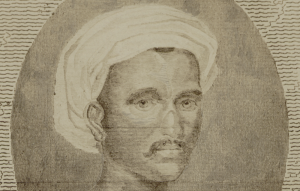
Assistant Professor Holly Shaffer recently won the American Institute of Indian Studies 2021 Edward Cameron Dimock, Jr. Prize in the Indian Humanities for her forthcoming book, Grafted Arts: The Marathas and the British in Western India, 1760-1820, which will be published by the Paul Mellon Centre in association with Yale University Press.
Professor Shaffer’s book, Grafted Arts, focuses on Maratha military rulers and British East India Company officials who used the arts to engage in diplomacy, wage war, compete for prestige, and generate devotion as they allied with, or fought against, each other to control western India in the eighteenth century. Professor Shaffer conceptualizes the artistic combinations that resulted as ones of “graft”—a term that acknowledges the violent and creative processes of suturing arts, and losing and gaining goods, as well as the shifting dynamics among agents who assembled such materials. By tracing grafted arts from multiple perspectives—Maratha and British, artist and patron, soldier and collector—this book charts the methods of empire building that recast artistic production and collection in western India and from there across India and in Britain.
This mercenary method of artistry propagated a wide range of mixed and fractured arts and took advantage of plundered ones. Professor Shaffer argues that such broken sculptures, scrappy self-portraits, and engravings of wax-formed noses—which would be identified as ephemeral, marginal, and interstitial in a conventional account—become vital evidence for a history of art that gains shape through assembly and juxtaposition. These arts, alongside oil paintings, religious murals, courtly albums, and printed books, emblematize how forms can transform by way of a different artist, patron, viewer, or troubling circumstance, from an artist who worked for Company officials like Gangaram Tambat to an artist like William Blake who drew on western Indian arts that returned with such officials to London. Indeed, these grafted arts iterated across India and Britain over the nineteenth century either to consolidate empire or revolt against it entirely; they still remain instigators of nationalist agitation today.

Göttingen State and University Library, Germany.
The AIIS Committee lauded Professor Shaffer for her “imaginative use of a ‘grafted arts’ framework to examine the artistic creations and collections that resulted from the intermixing of the Marathas and the British in the late eighteenth and early nineteenth centuries.” They noted that the “erudite and well-written book manuscript is also impressive in how effectively it engages the art, economic, military, political, and social histories of western India and the British Empire and draws on a rich array of source materials from archives and art collections in India, England, and the U.S. It is also unique in that it connects up moments, actors, and objects that are usually analyzed discretely and considers ‘western India as its center of inquiry with Britain a node in its network.’”
The American Institute of Indian Studies (AIIS) was formed in 1961 to further the knowledge of India in the United States by supporting American scholarship on India. The programs of AIIS foster the production of and engagement with scholarship on India, and promote and advance mutual understanding between the citizens of the United States and of India.